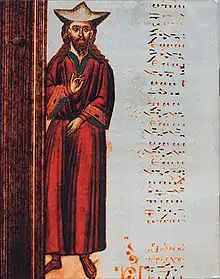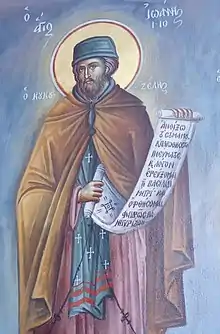John Koukouzelis
John Koukouzelis (Greek: Ιωάννης Κουκουζέλης, Ioannis Koukouzelis; fl. c. 1300–50) (Albanian: Jan Kukuzeli) was a Byzantine composer, singer and reformer of Byzantine chant.[1] He was recognized as a saint by the Eastern Orthodox Church after his death. Among the most illustrious musicians of the Palaiologos dynasty,[1] his music remains held in high esteem by Albanians, Bulgarians, Greeks,[2] Macedonians, Romanians and Serbs.[3]
John Koukouzelis | |
|---|---|
 St. John Koukouzelis depicted on a 15th-century musical codex at the Great Lavra Monastery, Mount Athos, Greece. | |
| Born | Dyrrhachium, Kingdom of Albania (medieval) |
| Venerated in | Eastern Orthodox Church |
Life and career
Koukouzelis was born in Dyrrhachium (modern-day Durrës, Albania) in the late 13th century to a father of unknown origins[4] (conjectured citation) and a Bulgarian mother.[5][6][7] He was orphaned in childhood.[8]
Koukouzelis' last name is allegedly derived either from the Greek word for broad beans (κουκιά, koukia) or the Albanian word for Red (Kuqe, arb. Cuccia) and a Slavic word for cabbage (зеле, zele).[9][10][11]
At a young age, he was noted and accepted into the school at the imperial court at Constantinople,[10] where he received his education and established himself as one of the leading authorities in his field during the time. A favourite of the Byzantine emperor and a principal choir chanter, he moved to Mount Athos and led a monastic way of life in the Great Lavra. Because of his singing abilities, he was called "Angel-voiced".[12]

Musical style and compositions
Koukouzelis established a new melodious ("kalophonic") style of singing out of the sticherarion.[13] Some years after the fall of Constantinople Manuel Chrysaphes characterised the sticheron kalophonikon and the anagrammatismos as new genres of psaltic art which were once created by John Koukouzelis.[14]

Reception
In general it is useful to make a distinction between compositions which can be verified as the compositions by John Koukouzelis, and those which are simply based on the method which he taught (as a stylistic category based on the kalophonic melos as exemplified by Mega Ison). Even concerning famous compositions, their authorship is often a subject of scholarly debates whose concern is not always the talent of one individual composer—like the Polyeleoi of the Bulgarian Woman dedicated to his mother that, according to some researchers, contains elements of traditional Bulgarian mourning songs.[6][12] Greek editions of the same Polyeleos are different and especially the authorship of the Kratema used in the Bulgarian edition has been a controversial issue.[15] Concerning stichera kalophonika, there are numerous compositions made up in his name, but his authorship must be regarded as a certain school which had a lot of followers and imitators.
Modern print editions of chant books have only a very few compositions (different melismatic echos varys realisations of Ἄνωθεν οἱ προφήται, several Polyeleos compositions, the cherubikon palatinon, the Mega Ison, the Anoixantaria) which are almost never sung, except the short Sunday koinonikon, for the very practical reason that most of John Koukouzelis' compositions, at least based on the exegetic transcriptions by Chourmouzios Chartophylakos (GR-An Ms. ΜΠΤ 703), are simply too long.[16]
Sainthood and legacy
Koukouzelis is regarded as the most influential figure in the music of his period. He was later recognized as a saint by the Eastern Orthodox Church, his feast day being on 1 October.[17]
A musical school in his native Durrës bears his name, Shkolla Jon Kukuzeli. Also, Kukuzel Cove in Livingston Island in the South Shetland Islands of Antarctica is named after Koukouzelis, using the Slavic form of his name.
References
- Williams 2001.
- "The Stewardship of St. John Koukouzelis - Parish & Church Life - Greek Orthodox Archdiocese of America".
- Casiday, Augustine (2012). The Orthodox Christian World. ISBN 9780415455169.
- Παπαγεωργίου, Αγγελική (2007). Ο Ιωάννης Β' Κομνηνός και η εποχή του (1118-1143) (Thesis). National Documentation Centre (EKT). doi:10.12681/eadd/19826.
- Kazhdan, Alexander, ed. (1991), "Koukouzeles, John", Oxford Dictionary of Byzantium, Oxford University Press, p. 1155, ISBN 978-0-19-504652-6,
There is evidence... that his mother was Bulgarian.
- "725 години от рождението на Йоан Кукузел" (in Bulgarian). Ruse Library website. Retrieved 6 May 2007.
- Maguire, Robert A.; Alan Timberlake (1998). American contributions to the Twelfth International Congress of Slavists. Slavica. p. 66. ISBN 978-0-89357-274-7.
For instance, the famous reformer of Byzantine music, loan Kukuzel (ca. 1302-ca. 1360), not only used his musical composition "Polieleos of a Bulgarian Woman" melodic elements from his mother's laments...
- "Venerable John (Koukouzelis)", Orthodox Church in America
- "Св. Йоан Кукузел — тропар, кондак и житие" (in Bulgarian). Pravoslavieto.com. Retrieved 6 May 2007.
- "St. John Kukuzelis". Orthodox America. Retrieved 6 May 2007.
- "Joan Kukuzeli".
- Бакалов, Георги; Милен Куманов (2003). "Йоан Кукузел (ок. 1280-1360)". Електронно издание "История на България" (in Bulgarian). София: Труд, Сирма. ISBN 954528613X.
- See as an example Maria Alexandru's study (2011) of John Koukouzelis' composition of a sticheron kalophonikon which he created over a part (ποὺς) of a traditional sticheron for Saint Demetrios.
- See the edition and translation by Dimitri Conomos (1985, 40–45).
- Sarafov's edition (1912, 201–203) has a teretismos which ends a fifth too high for the Polyeleos composition, his edition of compositions ascribed to John Koukouzelis is regarded as authoritative by Bulgarian chanters until today (listen to the interpretation of the Bulgarian Byzantine choir under direction of Dimiter Dimitrov).
- Some collections of stichera kalophonika made alone of the Menaion cycle—they were usually called "exercise books" (mathemataria)—have a volume of 1900 pages. In fact, even the traditional way to sing the sticheraric melos had been already so expanded, that the modern editions must all regarded as different efforts to abridge the traditional melos.
- Great Synaxaristes: (in Greek) Ὁ Ὅσιος Ἰωάννης ὁ ψάλτης ὁ καλούμενος Κουκουζέλης. 1 Οκτωβρίου. ΜΕΓΑΣ ΣΥΝΑΞΑΡΙΣΤΗΣ.
Sources
Manuscripts
- Koukouzeles, Ioannes; Korones, Xenos; Kladas, Ioannes (1400). "Vienna, Österreichische Nationalbibliothek, Cod. theol. gr. 185". Βιβλίον σὺν Θεῷ ἁγίῳ περιέχον τὴν ἄπασαν ἀκολουθίαν τῆς ἐκκλησιαστικῆς τάξεως συνταχθὲν παρὰ τοῦ μαΐστορος κυροῦ Ἰωάννου τοῦ Κουκουζέλη. Thessaloniki.
- Germanos Hieromonachos; Panagiotes the New Chrysaphes; Petros Bereketes; Anastasios Skete; Balasios Iereos; Petros Peloponnesios; Petros Byzantios. "Athens, Ιστορικό και Παλαιογραφικό Αρχείο (ΙΠΑ), MIET, Ms. Pezarou 15". Anthologiai of Psaltic Art (late 18th century). Athens: Μορφωτικό Ίδρυμα Εθνικής Τράπεζας. Archived from the original on 4 March 2016. Retrieved 29 September 2012.
- Koukouzeles, Ioannes (1819). Chourmouzios the Archivist (ed.). "Athens, National Library of Greece (EBE), Metochion of Panagios Taphos (ΜΠΤ) 703". Manuscript with Chourmouzios' transcriptions of 14th-century composers (Ioannes Glykys, Ioannes Koukouzeles, Xenos Korones, Ioannes Kladas etc.) according to the New Method. Istanbul.
{{cite web}}: Missing or empty|url=(help)
Print editions
- Petĕr V. Sarafov, ed. (1912). "Biografiya na Sv. Ioan Kukuzel, Iz carigradskaya prĕvod (Aniksantari, Golĕmoto Iso, Poleyleyat na Bĕlgarkata, Heruvimska pĕsn, Pričastno, Svyše prorocy)". Rĕkovodstvo za praktičeskoto i teoretičesko izučvane na Vostočnata cĕrkovna muzika, Parachodni uroci, Voskresnik i Antologiya (Polielei, Božestvena služba ot Ioana Zlatoousta, Božestvena služba na Vasilij Velikij, Prazdnični pričastni za prĕz cĕlata godina, Sladkoglasni Irmosi). Sofia: Peter Gluškov. pp. 131–216.
- Chourmouzios the Archivist (1896). Kyriazides, Agathangelos (ed.). "Τὸ Μέγα Ἴσον τῆς Παπαδικῆς μελισθὲν παρὰ Ἰωάννου Μαΐστορος τοῦ Κουκκουζέλη, Χερουβικὸν παλατινὸν, Κοινωνικὸν". Ἐν Ἄνθος τῆς καθ' ἡμᾶς Ἐκκλησιαστικῆς Μουσικῆς περιέχον τὴν Ἀκολουθίαν τοῦ Ἐσπερίνου, τοῦ Ὅρθρου καὶ τῆς Λειτουργίας μετὰ καλλοφωνικῶν Εἴρμων μελοποιηθὲν παρὰ διάφορων ἀρχαιῶν καὶ νεωτερῶν Μουσικόδιδασκαλων. Istanbul: Alexandros Nomismatides: 127–144, 278–287, 350–353.
Papadikai and their editions
- "Hiera Mone of Timios Prodromos (Skete) Veroias, Ms. 1". Papadike (1796). 1796. Retrieved 6 February 2013.
- Alexandrescu, Ozana (2011). "Tipuri de gramatici în manuscrise muzicale de tradiţie bizantină". Studii şi cercetări de istoria artei. Teatru, muzică, cinematografie. Serie novă. 49–50: 21–55.
- Alexandru, Maria (1996). "Koukouzeles' Mega Ison: Ansätze einer kritischen Edition" (PDF). Cahiers de l'Institut du Moyen-Âge grec et latin. 66: 3–23.
- Conomos, Dimitri, ed. (1985), The Treatise of Manuel Chrysaphes, the Lampadarios: [Περὶ τῶν ἐνθεωρουμένων τῇ ψαλτικῇ τέχνῃ καὶ ὧν φρουνοῦσι κακῶς τινες περὶ αὐτῶν] On the Theory of the Art of Chanting and on Certain Erroneous Views that some hold about it (Mount Athos, Iviron Monastery MS 1120, July 1458), Monumenta Musicae Byzantinae – Corpus Scriptorum de Re Musica, vol. 2, Vienna: Verlag der Österreichischen Akademie der Wissenschaften, ISBN 978-3-7001-0732-3.
- Fleischer, Oskar, ed. (1904), "Die Papadike von Messina", Die spätgriechische Tonschrift, Neumen-Studien, vol. 3, Berlin: Georg Reimer, pp. 15–50, fig. B3-B24 [Papadike of the Codex Chrysander], retrieved 11 April 2012.
- Hannick, Christian; Wolfram, Gerda, eds. (1985), Gabriel Hieromonachus: [Περὶ τῶν ἐν τῇ ψαλτικῇ σημαδίων καὶ τῆς τούτων ἐτυμολογίας] Abhandlung über den Kirchengesang, Monumenta Musicae Byzantinae – Corpus Scriptorum de Re Musica, vol. 1, Vienna: Verlag der Österreichischen Akademie der Wissenschaften, ISBN 3-7001-0729-3.
- Tardo, Lorenzo (1938), "Papadiche", L'antica melurgia bizantina, Grottaferrata: Scuola Tipografica Italo Orientale "S. Nilo", pp. 151–163.
Studies
- Alexandru, Maria (2011). "Byzantine Kalophonia, illustrated by St. John Koukouzeles' piece Φρούρηζον πανένδοξε in Honour of St. Demetrios from Thessaloniki. Issues of Notation and Analysis". Studii şi cercetări de istoria artei. Teatru, muzică, cinematografie. Serie novă. 49–50: 57–105.
- Angelopoulos, Lykourgos (1997). "The "Exegesis" of Chourmouzios Hartofylax on Certain Compositions by Ioannis Koukouzelis". In Christian Troelsgård (ed.). Byzantine Chant – Tradition and Reform: Acts of a Meeting Held at the Danish Institute at Athens, 1993. Monographs of the Danish Institute at Athens. Århus: Aarhus University Press. pp. 109–122. ISBN 8772887338.
- Williams, Edward V. (2001). "Koukouzeles [Papadopoulos], Joannes". Grove Music Online. Revised by Christian Troelsgård. Oxford: Oxford University Press. doi:10.1093/gmo/9781561592630.article.15428. ISBN 978-1-56159-263-0. (subscription or UK public library membership required)
External links
- Koukouzeles, Ioannes (13 December 2006). "John Koukouzeles' Teretismos composed in the mesos devteros sung by Ensemble Romeiko in Historic Costumes". National Library of Athens: Romeiko Ensemble. Archived from the original on 2 November 2013.
- Koukouzelis, Ioannis. "Sticheron kalophonikon about Φρούρηζον (Protect, o most glorious) in echos plagios devteros". Greek Byzantine Choir – Lycourgos Angelopoulos. Archived from the original on 14 December 2021.
- Kukuzel, Ioan. "Sunday Koinonikon Хвалите Господа с'небес in Glas 5". Sofia Priest Choir – Kiril Popov. Archived from the original on 14 December 2021.
- Kukuzel, Ioan. "Polielei na Bĕlgarkata in Glas 5 (extracts)". Bulgarian Byzantine Choir – Dimitar Dimitrov. Archived from the original on 14 December 2021.
- Koukouzelis, John. "Anoixantaria composed in echos plagios tetartos". Cappella Romana – Alexander Lingas. Archived from the original on 14 December 2021.
